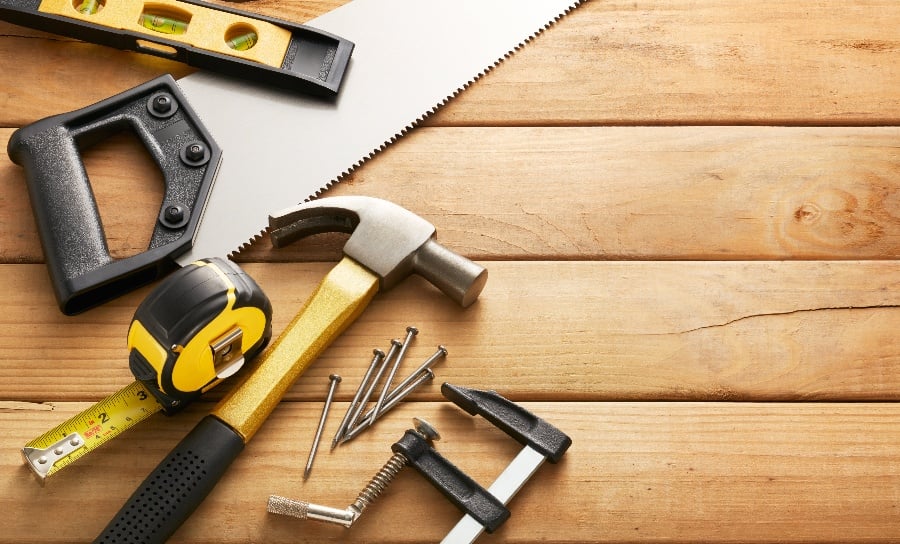Woodworking can be one of the most fulfilling types of home project disciplines for beginners and DIYers.
You can have a rewarding outcome, and following the tips below will ensure that you reduce your risk and optimize your outcome!
Staying Safe When Cutting
Maintaining your safety should be your primary concern as a beginner woodworker. This is especially true when you are cutting small parts.
Irregular parts can be quite difficult to hold, increasing the risk. In order to ensure your safety, attach the small parts to a scrap piece of wood.
Use a dowel screw to create the attachment, keep the assembly straight and ensure that your hands stay far away from the cutting blade.
Nominal Dimensions vs. Real Dimensions
One of the first things that a beginner will learn about woodworking is that the dimensions of the actual wood being used are not as they seem. The ubiquitous "two by four" board is actually not 2" x 4" – they are actually 1.5" by 3.5".
They are still called 2x4 boards out of tradition. The same goes for 4x4 boards – they are actually not 4" by 4", either.
A lawsuit now requires both nominal dimensions and real dimensions to be listed on packaging, so don't be confused when you see two sets of dimensions when you buy your wood.
Measuring Odd Widths
If you want really precise pieces, then you need a way to divide those odd numbered dimensions – those 3/8ths and 7/8ths that tend to show up when you are trying to build anything with a bit of artistic flair.
If you want to divide these dimensions without the need to divide fractions, simply angle your tape across the piece until it divides evenly. Mark your piece with the tape angled.
A Quick Mixing Surface
If you only need to mix a little bit of epoxy for a project, you do not have to use a dedicated container for it. You can create a DIY mixing surface right on your workbench by using nothing more than painter's tape.
All that you have to do is lay down pieces of the tape overlapping with each other so that you don't get any of the epoxy on your bench. After you are finished, all that you have to do is peel off the tape and discard it.
You can also use this trick for wood glue or similar materials that require quick accessibility.
Staining
One of the most difficult skills for beginners to master is staining pieces with deep recesses – things like lattice or chairs.
You can use an everyday spray bottle to make the job easier. Simply spray the area that you need and wipe up the excess with a clean rag.
Using a sprayer will allow you to get between those hidden and tight crevices that would otherwise be very hard to reach.

Stain Indexing
It can be hard to determine the exact stain that you need, and this problem only gets more difficult the more choice you have. Use this stain index to get the right stain every time.
First, use masking tape to create sections in your favorite wood boards. Apply your stains across each wood type through the entire width. Wait until the stains dry, then brush your finishes on lengthwise.
This will allow you to see how each finish looks with each stain. Give each one a label. You can use both sides of each board to double the space you have to create your index.

From Notepad to Sandpad
If you need to sand down some wicked curves, you can use a simple, everyday notepad to get the job done.
Notepads give you just the right amount of firmness and flexibility to sand around curves with complex arcs, like those artistic table and chair legs that must be rubbed down perfectly.
To hold the sandpaper in place, slip one end of it between the pages of the notepad.
Don't Throw Away that Glue
You can reinvigorate your Elmer's wood glue even if you leave the top off by mistake and it becomes too thick to use.
Just drop in the smallest bit of vinegar and watch as your glue becomes brand new again. This tip may seem small, but your savings will quickly add up over time.
Cutting Sandpaper
You don't want to use your utility knives or project scissors to cut sandpaper if you can help it.
You may see woodworking masters do this, but there is a better way to get the size that you need without dulling your utility blades needlessly. Connect a hacksaw blade that you are not using to the workbench edge.
Put a washer behind the hacksaw at the mounting holes so that you can slide a sheet of sanding paper easily behind the metal. For easy cutting, pre-fold the paper exactly where you want it to be cut.
Aligning Angles Easily
Are you having trouble lining up and clamping your mitered edges? If you are, then you may be able to use painter's tape to help. Set up the troublesome edges with the outer part facing up.
Use the painter's tape to hold them edge to edge. Flip these over so that you can easily access the beveled edges, then glue them together. Finally, tape the last two edges and leave it for a while.
Painter's tape is a great option because it removes easily, and the glue won't attach to it. Finishing and sanding will be that much easier because of it.

Sanding Curved Surfaces
Do you need to sand the inside of a hole? Make it easy by inserting a 1/4 x 3" bolt into a holesaw's pilot hole. Use a nut and washer to make a secure connection. Cut a 1/4" slot that aligns with the bolt using your hacksaw.
After that, cut sandpaper backed with adhesive so that one end slides into the slot. Wrap the sandpaper around the cutout and put the other end back into the slot.
Take a drill and chuck the bolt, and you have a ready-made drum sander.
Make Your Own Standoffs
Standoffs are easily purchased if you need to finish both sides of a piece without waiting for either to dry.
However, you can save a bit of money with this DIY trick. Take 2" drywall screws and insert them through 2" x 2" squares using 3/4" stock.
You can touch up the divots that these screw points will leave a bit later, but in the meantime, you can rest your piece on the screws to let the finish dry.
Make Your Own Dust Chute
Once you really get into a project, you will probably find that cleaning up shavings afterwards is a problem. Save yourself a bit of work with a homemade dust chute using a couple of caps and a 4" PVC sewer pipe.
First create a slit in the pipe. Use your heat gun to get the plastic soft so that you can open the slit. Make sure that you have proper ventilation, because heating PVC will create toxic fumes.
Screw the flap to the planer housing after drilling holes in it. Finally, attach your vacuum hose to a 2.5" hold that you will cut in the end cap.
Make Stronger Sandpaper
If you use a sandpaper block, you may get a bit more strength, but you lose the finer grits. Experts know that sanding more precisely has to be done with thinner paper.
However, this paper is usually thin and may tear even before the grit is used up. Fix this problem by putting duct tape on the back of thin sandpaper.
You retain the flexibility and get more durability.

Elastic Clamps
Do you have an old bicycle that you don't use anymore? The inner tubes on the bike work very well as clamps for projects with crazy angles.
All you need to do is knot the tube so that it properly matches the size of your project and stretch it over.
The 15 tips above will get you started woodworking even if you have no previous experience. Keep in mind that woodworking is just as much art as it is science.
On your way to mastery, you will have to experiment once you learn the basics. Don't ever give up learning, and vet every tip that you receive to make sure that it works for you.




